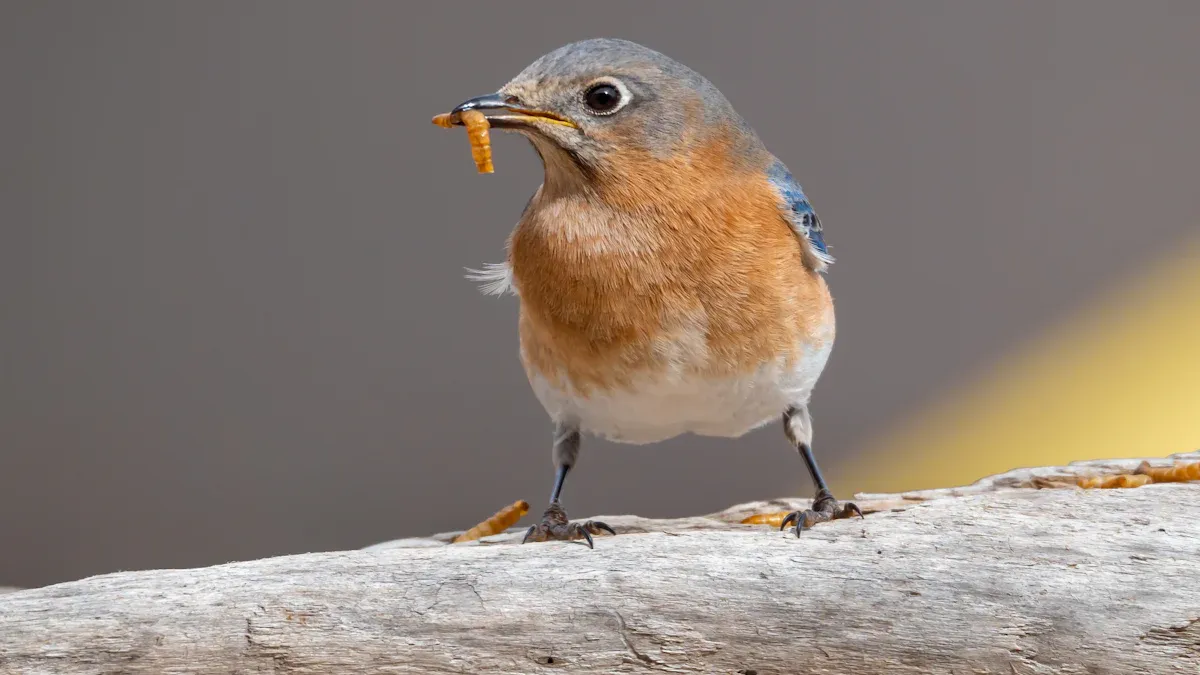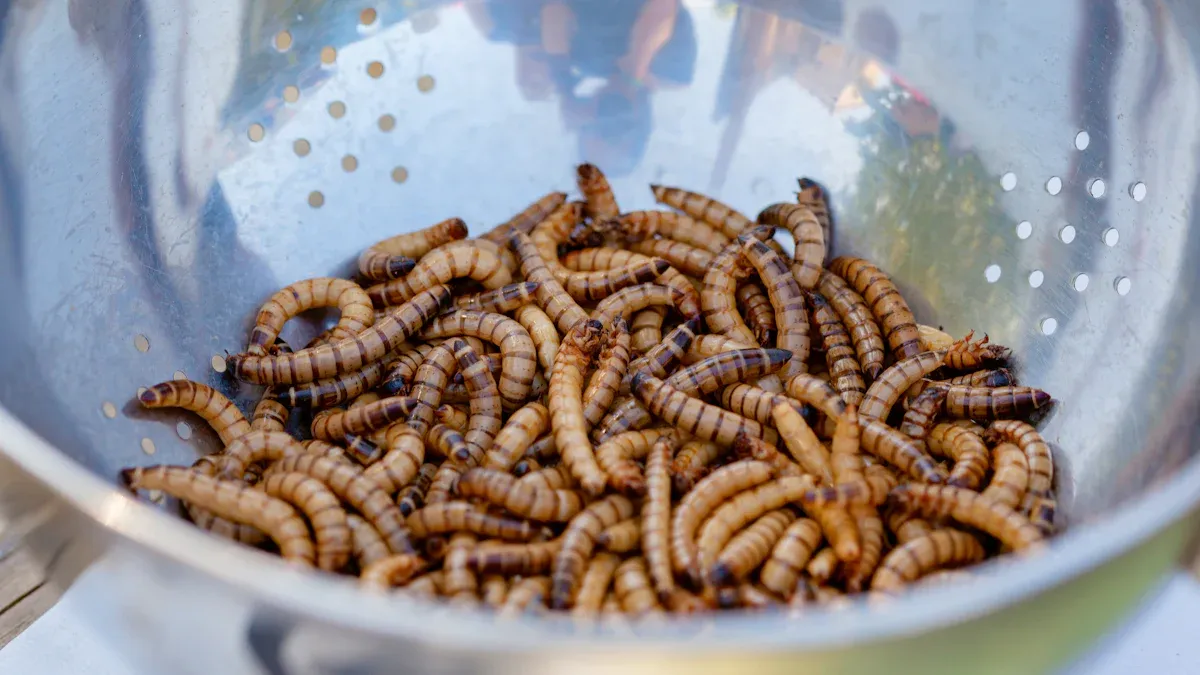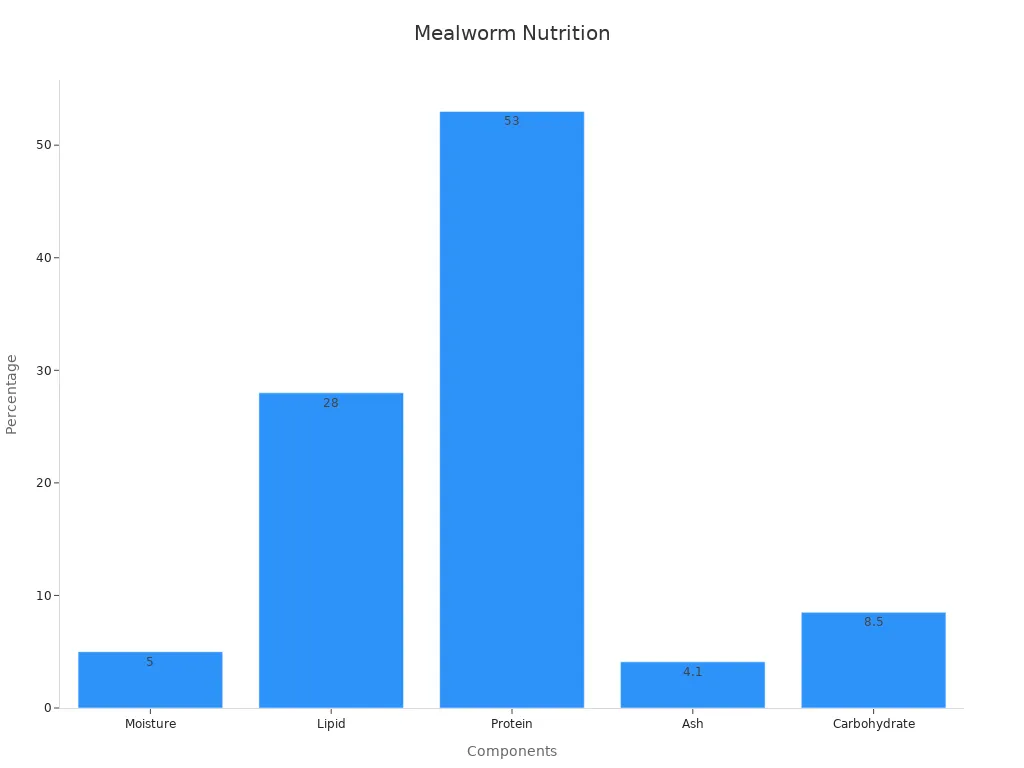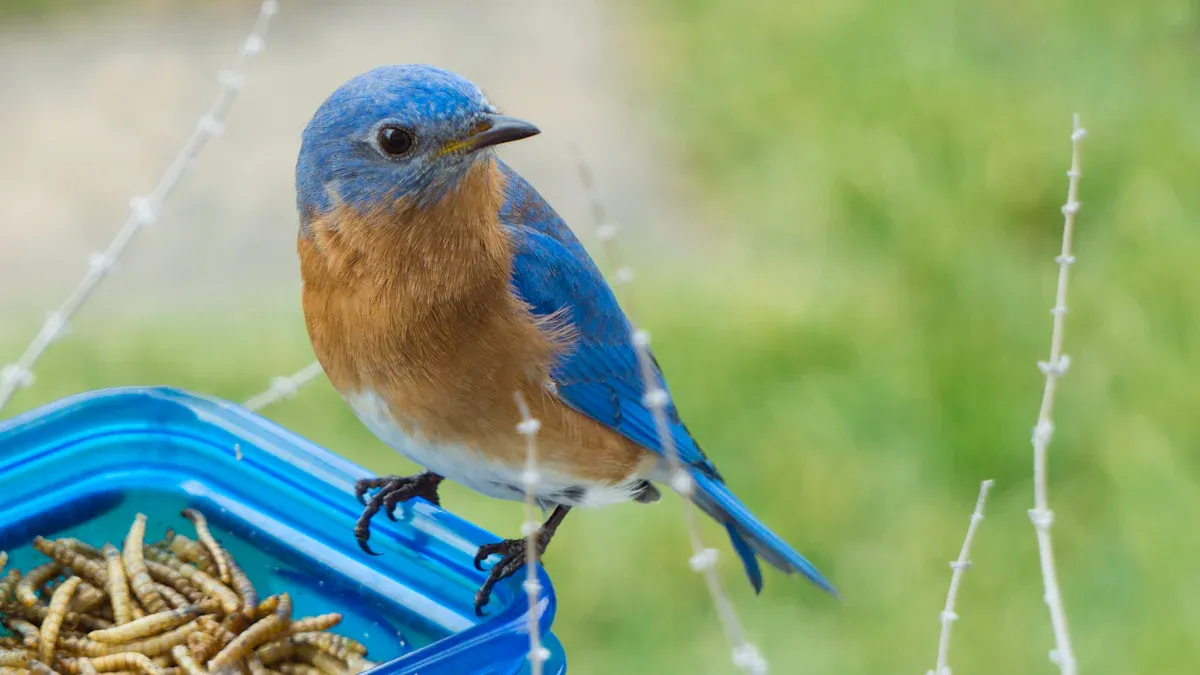
Bird lovers often look for ways to keep their feathered visitors healthy and happy. Dried mealworms for birds offer a convenient and nutritious option. Packed with protein and essential nutrients, these tiny treats support growth, energy, and overall health. Whether feeding robins, bluebirds, or wrens, mealworms can make any backyard a bird haven.
Key Takeaways
- Dried mealworms have 53% protein. They help birds grow and stay energized, especially during breeding season.
- These mealworms also have healthy fats like omega-6 and omega-3. These fats improve birds’ strength and health for migration and daily tasks.
- Feeding dried mealworms brings many bird types to your yard. This makes your yard a fun place for birdwatching fans.
Nutritional Benefits of Dried Mealworms for Birds

High Protein for Growth and Development
Protein plays a vital role in helping birds grow strong and healthy. Dried mealworms for birds are packed with protein, making them an excellent choice for supporting feather development, muscle growth, and overall vitality. With a protein content of 53%, these tiny treats provide more protein than many other bird food options.
Here’s a breakdown of the nutritional composition of dried mealworms:
| Nutritional Component | Percentage |
|---|---|
| Moisture | 5% |
| Lipid | 28% |
| Protein | 53% |
| Ash | 4.1% |
| Carbohydrate | 8.5% |
This high protein content is especially beneficial during the breeding season when birds need extra energy to care for their young. Whether it’s a robin building its nest or a bluebird feeding its chicks, dried mealworms provide the nutrients they need to thrive.

Essential Fats for Energy and Health
Fats are another critical component of a bird’s diet, and dried mealworms deliver plenty of them. With 28% lipid content, these treats provide the energy birds need for daily activities like flying, foraging, and even migrating. Essential fatty acids, such as omega-6 and omega-3, play a key role in enhancing endurance and overall health.
Studies show that birds with higher levels of these fatty acids perform better during long flights. For example:
- Birds with omega-6 and omega-3 PUFA had improved exercise performance during migration.
- Fatty acids from mealworms contributed to better energy reserves in migratory birds.
- These fats also supported feather growth and repair, helping birds maintain vibrant plumage.
By offering dried mealworms for birds, backyard enthusiasts can help their feathered friends stay energetic and healthy year-round.
Vitamins and Minerals for Vitality
Dried mealworms aren’t just about protein and fats—they’re also rich in essential vitamins and minerals. These nutrients play a crucial role in keeping birds active and resilient. For instance, mealworms contain high levels of potassium, sodium, magnesium, and calcium, which are vital for bone strength, muscle function, and overall health.
Here’s a comparison of mineral content between dried mealworms and other supplements:
| Mineral | Mealworms (cell-fed) | Wheat Bran (fed) |
|---|---|---|
| Potassium (K) | High | N/A |
| Sodium (Na) | High | N/A |
| Magnesium (Mg) | High | N/A |
| Calcium (Ca) | High | N/A |
| Copper (Cu) | Low | N/A |
These minerals help birds stay active, whether they’re hopping around the yard or soaring through the skies. Adding dried mealworms to their diet ensures they get the nutrients they need to stay strong and vibrant.
Dried Mealworms for Birds vs. Other Food Options
Comparison with Seeds
Seeds are a staple in many bird feeders, but how do they stack up against dried mealworms for birds? While seeds like sunflower or millet provide essential nutrients, they often lack the high protein and fat content that mealworms offer. Protein is crucial for muscle development and feather growth, especially during breeding and molting seasons.
Here’s a quick comparison of the nutritional value of mealworms and soybean meal, a common seed-based bird food:
| Nutrient | Mealworm Meal (per 100g) | Soybean Meal (per 100g) |
|---|---|---|
| Crude Protein | 59.2 g | 44 g |
| Crude Fat | 24 g | 0.5 g |
| Gross Energy | 2.8 MJ | 1.7 MJ |
Mealworms clearly outshine seeds in protein and fat content, making them a better choice for birds needing extra energy. However, seeds still play an important role in providing fiber and carbohydrates, which help round out a bird’s diet. Offering both can create a balanced feeding station that caters to a variety of bird species.
Comparison with Suet
Suet is another popular bird food, especially in colder months when birds need extra calories to stay warm. It’s a high-energy food made from animal fat, often mixed with seeds or grains. While suet provides easily metabolized energy, dried mealworms for birds offer a more protein-rich alternative.
| Food Type | Nutritional Value | Moisture Content |
|---|---|---|
| Dried Mealworms | Less nutritional value, mainly protein | Little to no moisture |
| Suet | High-energy food, easily metabolized by birds | High moisture content, beneficial for young birds |
Suet attracts species like woodpeckers, chickadees, and nuthatches, making it a great option for diversity. However, dried mealworms are more versatile. They appeal to a broader range of birds, including insectivores like bluebirds and robins. For bird enthusiasts, combining suet and mealworms can maximize the variety of visitors to their yard.
Comparison with Fresh Insects
Fresh insects are a natural part of a bird’s diet, but they’re not always practical for backyard feeding. Dried mealworms for birds offer a convenient alternative with a similar nutritional profile. They’re easier to store, less messy, and available year-round.
Fresh insects, like caterpillars or beetles, provide hydration due to their moisture content. However, dried mealworms compensate for this with their concentrated nutrients. Birds can get the same protein and fat benefits without the hassle of sourcing live insects. Plus, dried mealworms are less likely to attract unwanted pests, making them a cleaner option for feeders.
Tip: To mimic the appeal of fresh insects, soak dried mealworms in water before offering them to birds. This rehydrates the mealworms and makes them even more enticing to your feathered friends.
How Dried Mealworms Benefit Backyard Birds

Supporting Energy Needs Year-Round
Birds need consistent energy to thrive, no matter the season. Dried mealworms for birds are an excellent source of fuel. They contain about 50% protein by weight, which helps birds maintain muscle strength and energy levels. These mealworms are also packed with essential fatty acids, vitamins, and minerals that support organ function and overall health.
During migration, birds rely on energy reserves to complete their long journeys. Mealworms help them build these reserves, ensuring they stay strong throughout the trip. In winter, when natural food sources like insects and berries are scarce, mealworms provide a reliable supplement. They also play a vital role during the breeding season, giving birds the nutrients they need to care for their young.
- High protein supports muscle development.
- Essential fats boost energy and endurance.
- Nutrients help birds survive harsh winters and demanding migrations.
By offering mealworms year-round, backyard bird enthusiasts can help their feathered visitors stay healthy and active.
Enhancing Breeding and Nesting Success
Mealworms can make a big difference during the breeding season. Birds expend a lot of energy building nests, laying eggs, and feeding their chicks. Adding mealworms to their diet gives them the extra boost they need. Studies have shown that house sparrows fed mealworms had higher chick survival rates. Similarly, great tits in urban areas experienced improved breeding success when mealworms were part of their diet.
Bluebirds also benefit from mealworms. Research in Minnesota found that bluebirds supplemented with mealworms had stronger immune responses to parasites. This means healthier parents and chicks, leading to better nesting outcomes. Providing mealworms during this critical time helps birds raise their young successfully.
Attracting a Variety of Bird Species to Your Yard
Dried mealworms for birds are a magnet for many species. Insect-eating birds like bluebirds, robins, and wrens find them irresistible. Even seed-eating birds may enjoy mealworms as a protein-rich treat. Offering mealworms can transform a backyard into a bustling bird sanctuary.
To attract a variety of species, place mealworms in a feeder or scatter them on the ground. Birds will quickly learn where to find this nutritious snack. Over time, you might notice new visitors, adding diversity and excitement to your birdwatching experience.
Tip: Soaking dried mealworms in water can make them even more appealing to birds, especially during hot summer days or dry seasons.
Practical Tips for Using Dried Mealworms for Birds
Storage and Shelf Life
Proper storage keeps dried mealworms fresh and safe for birds. Heat and moisture can spoil them quickly, reducing their nutritional value. To avoid this, store mealworms in an air-tight container. A freezer or refrigerator works best, as it keeps them cool and away from light. This method ensures they remain fresh for months, making them a reliable food source for backyard birds.
Studies suggest that dried mealworms stored in optimal conditions—away from heat and moisture—retain their quality longer. This prevents rancidity and ensures birds receive the nutrients they need.
Cost and Value for Bird Enthusiasts
Dried mealworms for birds offer great value for bird lovers. While they may seem pricier than seeds or suet, their high protein and fat content make them worth the investment. A small amount goes a long way in supporting bird health and energy. Bulk purchases can reduce costs, and their long shelf life means less waste. For bird enthusiasts, mealworms provide a practical and nutritious option that attracts a variety of species to the yard.
Best Ways to Offer Dried Mealworms to Birds
Presenting dried mealworms effectively can make your yard a favorite spot for birds. During summer, a diverse buffet of seeds, fruits, and mealworms increases visits from different species. Many birds prefer natural foods but will flock to feeders stocked with nutritious options.
Here are some tips for offering mealworms:
- Ensure mealworms are fresh or recently molted for better digestibility.
- Gut load mealworms before feeding to enhance their nutritional value.
- Pair mealworms with seeds like black oil sunflower to attract seed-eating birds.
- Include fruits like apple chunks or orange halves to cater to fruit-loving species.
For insectivorous birds, dried mealworms are a hit. Soaking them in water can mimic the appeal of fresh insects, making them even more enticing. By meeting birds’ dietary needs, backyard birders can enjoy frequent visits and a lively yard.
Dried Mealworms for Birds offer a practical and nutritious solution for backyard feeding. They provide essential nutrients that boost energy, health, and breeding success. Bird enthusiasts can attract diverse species by adding mealworms to feeders. These treats make any yard a lively haven for feathered visitors year-round.
FAQ
Can dried mealworms attract birds that don’t eat insects?
Yes! Many seed-eating birds enjoy mealworms as a protein-packed snack. Pair them with seeds or fruits to appeal to a wider variety of species. 🐦
Should dried mealworms be soaked before feeding?
Soaking isn’t required, but it helps mimic fresh insects. Birds love the added moisture, especially during hot weather or dry seasons. Try it for extra appeal! 💧
How often should dried mealworms be offered?
Offer them daily or during peak seasons like winter and breeding. Birds will appreciate the consistent energy boost and return to your yard regularly.


